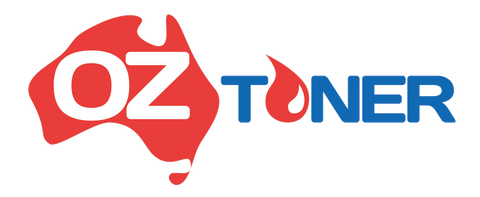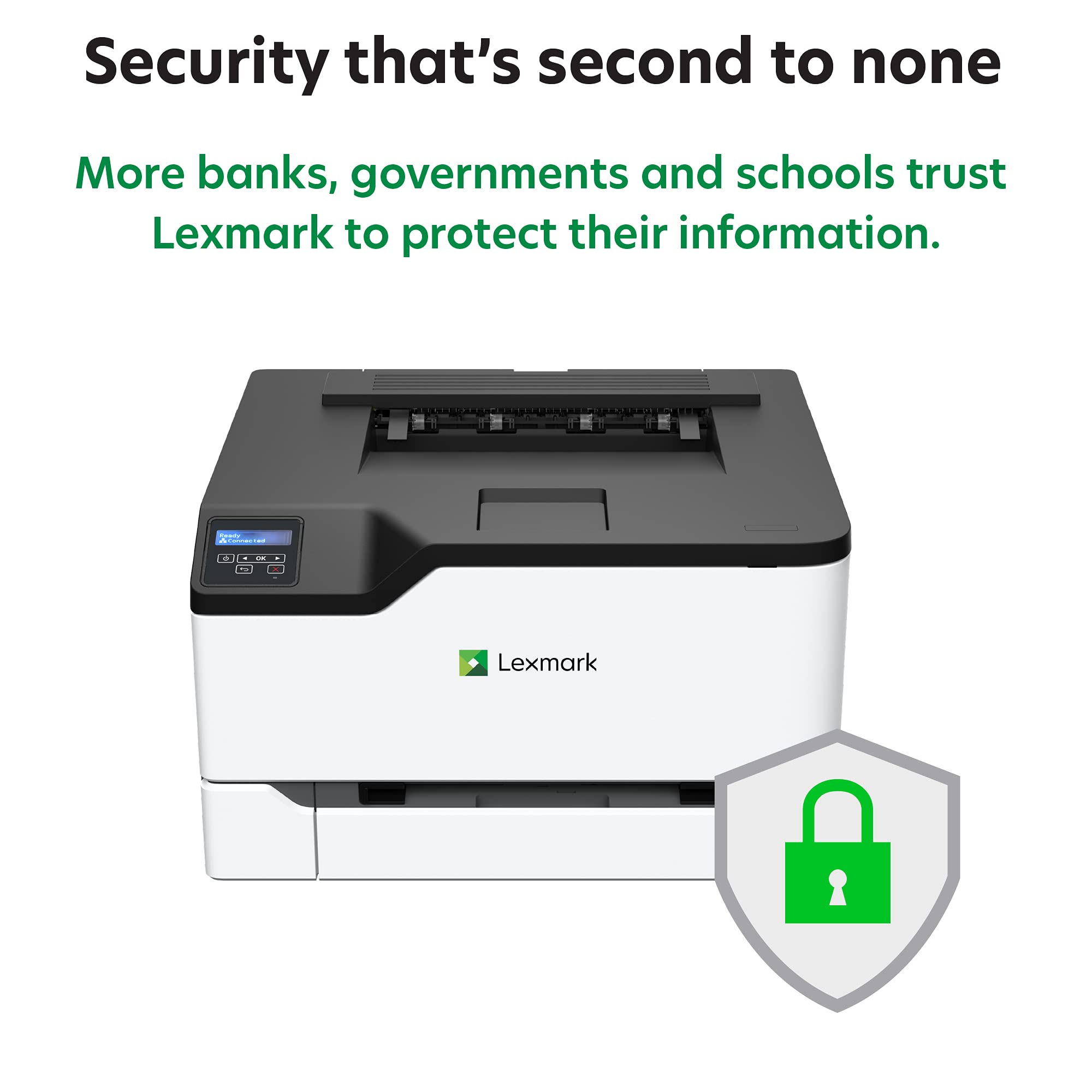Lexmark's entry-level C3326dw color laser printer produces quality output, is relatively fast, and supports most operating systems and platforms. Aside from the high running costs typical of lower-end laser machines, there's little to complain about.

BOTTOM LINE
-
PROS
- High recommended and maximum volume ratings.
- Robust security for price.
- Good print quality.
-
CONS
- Lacks Wi-Fi Direct and NFC.
- Somewhat steep running costs.
- No USB thumb drive or flash card support.
The Lexmark C3326dw ($279) is an entry-level, single-function color laser printer designed for use in small offices or workgroups or as a personal desktop printer. Like our Editors' Choice low-end color laser, Brother's HL-L3270CDW, the Lexmark prints well at relatively fast speeds, though it costs a bit more per page to use. Otherwise, this is a highly capable printer and a strong alternative to our current color laser favorite.
Small and Capable
At 9.6 by 16.2 by 15.5 inches (HWD) and weighing 35.5 pounds, the C3326dw is somewhat smaller and lighter than some popular competitors, including the Brother mentioned above, as well as the Canon Color imageClass LBP612Cdw (another PCMag favorite). Still another prime pick, Epson's WorkForce Pro WF-C5290 Network Color Printer, an inkjet laser alternative, is significantly larger in all directions than the Lexmark but weighs about the same.
The bottom line is that the C3326dw and similar laser printers should fit comfortably on most desktops, while the Epson laser alternative is big enough that it may require its own dedicated countertop, shelf, or another sturdy surface.
As a single-function machine, functionality consists primarily of printing from a PC or mobile device, thereby requiring little by way of controls. The control panel, then, is comprised of a handful of buttons and navigation keys anchored by a two-line monochrome LED, shown here.

You can configure the printer, set up security, monitor consumables and usage, and much more from the control panel, though wading through the drill-down menus can be cumbersome. Alternatively, you can use the C3326dw's built-in web portal, accessible from nearly any browser including your smartphone's, to perform these tasks and others such as, say, generating usage reports or restricting access (discussed in the next section).

In addition to Lexmark's standard page description language (PDL), the C3326dw aims to provide better compatibility with desktop publishing and graphics design applications, as well as integration with a few specific enterprise environments and workflows, by emulating HP's Printer Command Language (PCL) versions 5 and 6, as well as Adobe's PostScript 3.
Paper input capacity consists of one 250-sheet cassette and a single-sheet override tray for zipping out one-off envelopes, labels, and other media that might otherwise cause you to remove and reload the main tray. Brother's HL-L3270CDW also holds 250 sheets but lacks an override tray, while Canon's LBP612Cdw holds 151 sheets. Epson's WF-C5290, on the other hand, holds 330 sheets and is expandable to 830.

The C3326dw's maximum monthly duty cycle is 50,000 prints, with a maximum monthly print volume of 2,500 pages. That duty cycle is 20,000 pages higher than those of the Brother HL-L3270CDW, Canon LBP612Cdw, and HP Color LaserJet Pro M252dw.
Connecting and Securing the C3326dw
Though it's not quite as robust as some competitors—it lacks Wi-Fi Direct, near-field communication (NFC), and Google Cloud Print—the Lexmark's connectivity options provide adequate support for most operating systems and mobile devices.
For example, you get 802.11b/g/n Wi-Fi, 10/100BaseTX Ethernet, and the ability to connect to a single PC via USB 2.0. Supported operating systems are Windows versions 7 through 10 and Windows Server, Apple macOS and iOS, and several Linux, Citrix, and Novell flavors. Mobile device support comes via Apple AirPrint, Mopria (Android), and Lexmark's Mobile Print App (Android and iOS).

Security includes controlling access to functions, including the ability to print color or deny access by group, user, or IP address. The Confidential Print Setup feature lets you deploy up to 10 PINs to secure documents in the C3326dw's memory, allowing only those users who know a document's PIN to print it. You can also restrict access to both the printer and the embedded web server by the number of failed attempts, set expiration options, and keep duplicate copies of all documents on the printer.
Respectable Print Speeds
Lexmark rates the C3326dw at 26 pages per minute (ppm) for one-sided (simplex) pages and half that for two-sided (duplex) pages. Like most Lexmark laser printers, it defaults to two-sided printing, meaning that the printer driver is set to print on both sides of the paper. In these instances, we test and record a machine's simplex and duplex speeds. I clocked the C3326dw from our standard Intel Core i5 testbed running Windows 10 Pro.
The C3326dw churned out our lightly formatted 12-page Microsoft Word text document at the rate of 26.4ppm for single-sided prints and 15ppm for two-sided pages. These results beat Canon's LBP612Cdw, which also defaults to duplex printing, by 8.6ppm in simplex and 5.3ppm in duplex mode. The Brother and Epson models mentioned earlier do not default to two-sided printing, so we have only their simplex speeds recorded in our database.
With that in mind, the C3326dw beat the WF-C5290 by 1ppm and led the HL-L3270CDW by 1.4ppm, though Brother's midrange HL-L8260CDW trounced my test unit by 6.6ppm.
Next, I clocked the C3326dw as it printed our collection of colorful and complex Adobe Acrobat PDFs; Excel spreadsheets, charts, and graphs; and PowerPoint handouts containing business graphics and multiple fonts at varying sizes and colors. I combined these results with those from printing the 12-page Word document and came up with an average of 11ppm simplex and 8.9ppm duplex, which barely beat the Canon color laser. The Brother HL-L3720CDW proved 0.6ppm slower, while the Epson WF-C5290 was 5.1ppm faster.
Admirable Output Quality
When it comes to print quality, not all lasers are created equal, especially when printing color documents. Pages from the Lexmark color machines I've tested recently, however, indicate that the company's color laser print engine is well-tuned, producing bright hues with accurate color matching as well as the near-typesetter-quality text for which laser printers are known.
As expected, the C3326dw delivered pristine-looking type down to the smallest size we test, 4 points. Even some of the harder-to-read decorative and display fonts we use came out with better-than-average legibility and attractively shaped and spaced characters.
The C3326dw also did our full-page Excel charts and graphs justice, with little to no banding in solid fills and intricate gradients. The collection of embedded and standalone photos in our testing regimen looked above average and well worthy of marketing materials such as real estate flyers or product catalogs. I've no complaints about the C3326dw's print quality.
Pricey Prints
One drawback to laser printers, especially entry-level models like this one, is that they cost a bit too much to use. If, for example, you buy Lexmark's highest yield "returnable" toner cartridges (you must recycle them through Lexmark to get the lowest prices), your running costs will come out to about 3 cents for monochrome pages and 15 cents for color.
As low-cost color lasers go, these numbers are middle-of-the-road. If you print this machine's full recommended volume of 2,500 pages each month, compared to some alternatives such as a higher-volume color laser or a heavy-duty inkjet, you could spend more than $600 per year on consumables—enough to buy two C3326dw printers with money left over.

As for the Lexmark's most direct competitors, Canon's LBP612Cdw is actually a bit more expensive at 3.2 cents for black and 16.3 cents for color pages. The Brother HL-L3720CDW comes in a little lower for monochrome (2.6 cents) and a little higher for color (15.5 cents). Some midrange color lasers, such as Brother's HL-L8360CDW (1.9 cents black and 10 cents color), will save significantly on toner.
If typeset-quality text isn't required, however, a laser alternative such as the Epson WF-C5290 we've been talking about here (1.7 cents black and 7.7 cents color) can save you truly meaningful money. Still, if you only need to churn out 200 or 300 pages per month, the C3326dw's running costs are competitive.
At Home on the Desktop
Competition in the economy color laser space is fierce, and the contenders—most of them, anyway—are all capable machines with, often, very little in terms of features, speed, and print quality separating them. That's where the Lexmark C3326dw falls. It's as capable as our Brother HL-L3720CDW top pick, though it lists for about $50 more and its monochrome pages are slightly more costly. Even so, when you print only a few hundred pages each month, a fraction of a cent here or there doesn't matter much, making the Lexmark a first-class alternative to our Brother HL-L3270CDW and Canon LBP612Cdw entry-level color laser favorites, especially if you can find it on sale.



